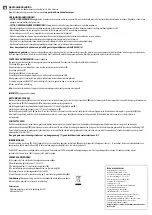
Planning the Installation
2
•
SIREN TIMEOUT set to 5 minutes.
•
CSA Certified Accessories
•
Residential Burglary Alarm System Unit (ULC-S309)
•
Same as “UL Basic System and Household Burglary Alarm System Unit (UL 1023).” Except,
transformer (22-117-CN) must be used.
California State Fire Marshall Listed Systems
Same as Household Fire Warning System (UL 985).
Planning the
Installation
This section describes the Allegro™ system’s capabilities. It will help you get familiar with the
system. Appendix B provides planning sheets with tables that let you record the hardware and
programming configuration of the system to help prepare for system installation.
Standard System
Note
Before beginning installa-
tion, installers must verify
compatibility with the listed
central station receivers indi-
cated per installation.
Panel
The panel keypad provides complete system programming and operation control. Displays sys-
tem messages and indicates system status.
The following describes the system’s basic (out-of-box) hardware capabilities.
•
Power: AC Class II, 8 VAC transformer.
•
Backup Battery 4.8 VDC rechargeable NiCd battery pack.
•
One Supervised Hardwire Zone: Input for various hardwired detectors.
•
Built-In Radio Receiver: Allows use of up to 20 GE Interlogix 319.5 MHz. Crystal and/or
SAW Learn Mode wireless sensors and touchpads.
•
Built-In Siren: Capable of 85 dB @ 3m.
•
Built-In Panel Keypad.
•
Liquid Crystal Display (LCD).
DTIM
Note
The DTIM does not have a
backup battery.
The Dialog Telephone Interface Module (DTIM) allows the panel to communicate with the cen-
tral monitoring station.
Additional System Components
Note
Both SAW and Crystal sen-
sors function with this con-
trol panel.
See the Allegro Product Cat-
alog for a complete list of
compatible sensors.
The system can monitor up to 20 sensors using any combination of the following sensors:
•
Door/Window Sensor (60-670-95R)
•
2-Button Keychain Touchpad (60-607-319.5)
•
Remote Handheld Touchpad (60-671-95R)
•
Indoor Motion Sensor (60-639-95R)
•
Carbon Monoxide Alarm (60-652-95) (Not investigated by UL)
•
Smoke Sensor (60-848-95)
•
ShatterPro Glass Break (60-873-95)
Installing the
System
Before starting the installation, plan your system layout and programming using the worksheets
provided in Appendix B.
Installing the system consists of the following:
•
Determining the panel location.
•
Mounting the panel.
•
Identifying main panel components.
•
Connecting detection devices to panel zone input.
•
Installing an RJ-31X phone jack for the DTIM.
•
Connecting the AC power transformer.
•
Powering up the panel.
Содержание Allegro
Страница 6: ...iv ...









































